Chaoyue Song
Puppeteer: Rig and Animate Your 3D Models
Aug 14, 2025



Abstract:Modern interactive applications increasingly demand dynamic 3D content, yet the transformation of static 3D models into animated assets constitutes a significant bottleneck in content creation pipelines. While recent advances in generative AI have revolutionized static 3D model creation, rigging and animation continue to depend heavily on expert intervention. We present Puppeteer, a comprehensive framework that addresses both automatic rigging and animation for diverse 3D objects. Our system first predicts plausible skeletal structures via an auto-regressive transformer that introduces a joint-based tokenization strategy for compact representation and a hierarchical ordering methodology with stochastic perturbation that enhances bidirectional learning capabilities. It then infers skinning weights via an attention-based architecture incorporating topology-aware joint attention that explicitly encodes inter-joint relationships based on skeletal graph distances. Finally, we complement these rigging advances with a differentiable optimization-based animation pipeline that generates stable, high-fidelity animations while being computationally more efficient than existing approaches. Extensive evaluations across multiple benchmarks demonstrate that our method significantly outperforms state-of-the-art techniques in both skeletal prediction accuracy and skinning quality. The system robustly processes diverse 3D content, ranging from professionally designed game assets to AI-generated shapes, producing temporally coherent animations that eliminate the jittering issues common in existing methods.
ADHMR: Aligning Diffusion-based Human Mesh Recovery via Direct Preference Optimization
May 15, 2025Abstract:Human mesh recovery (HMR) from a single image is inherently ill-posed due to depth ambiguity and occlusions. Probabilistic methods have tried to solve this by generating numerous plausible 3D human mesh predictions, but they often exhibit misalignment with 2D image observations and weak robustness to in-the-wild images. To address these issues, we propose ADHMR, a framework that Aligns a Diffusion-based HMR model in a preference optimization manner. First, we train a human mesh prediction assessment model, HMR-Scorer, capable of evaluating predictions even for in-the-wild images without 3D annotations. We then use HMR-Scorer to create a preference dataset, where each input image has a pair of winner and loser mesh predictions. This dataset is used to finetune the base model using direct preference optimization. Moreover, HMR-Scorer also helps improve existing HMR models by data cleaning, even with fewer training samples. Extensive experiments show that ADHMR outperforms current state-of-the-art methods. Code is available at: https://github.com/shenwenhao01/ADHMR.
MagicArticulate: Make Your 3D Models Articulation-Ready
Feb 18, 2025Abstract:With the explosive growth of 3D content creation, there is an increasing demand for automatically converting static 3D models into articulation-ready versions that support realistic animation. Traditional approaches rely heavily on manual annotation, which is both time-consuming and labor-intensive. Moreover, the lack of large-scale benchmarks has hindered the development of learning-based solutions. In this work, we present MagicArticulate, an effective framework that automatically transforms static 3D models into articulation-ready assets. Our key contributions are threefold. First, we introduce Articulation-XL, a large-scale benchmark containing over 33k 3D models with high-quality articulation annotations, carefully curated from Objaverse-XL. Second, we propose a novel skeleton generation method that formulates the task as a sequence modeling problem, leveraging an auto-regressive transformer to naturally handle varying numbers of bones or joints within skeletons and their inherent dependencies across different 3D models. Third, we predict skinning weights using a functional diffusion process that incorporates volumetric geodesic distance priors between vertices and joints. Extensive experiments demonstrate that MagicArticulate significantly outperforms existing methods across diverse object categories, achieving high-quality articulation that enables realistic animation. Project page: https://chaoyuesong.github.io/MagicArticulate.
High Quality Human Image Animation using Regional Supervision and Motion Blur Condition
Sep 29, 2024



Abstract:Recent advances in video diffusion models have enabled realistic and controllable human image animation with temporal coherence. Although generating reasonable results, existing methods often overlook the need for regional supervision in crucial areas such as the face and hands, and neglect the explicit modeling for motion blur, leading to unrealistic low-quality synthesis. To address these limitations, we first leverage regional supervision for detailed regions to enhance face and hand faithfulness. Second, we model the motion blur explicitly to further improve the appearance quality. Third, we explore novel training strategies for high-resolution human animation to improve the overall fidelity. Experimental results demonstrate that our proposed method outperforms state-of-the-art approaches, achieving significant improvements upon the strongest baseline by more than 21.0% and 57.4% in terms of reconstruction precision (L1) and perceptual quality (FVD) on HumanDance dataset. Code and model will be made available.
Sync4D: Video Guided Controllable Dynamics for Physics-Based 4D Generation
May 27, 2024



Abstract:In this work, we introduce a novel approach for creating controllable dynamics in 3D-generated Gaussians using casually captured reference videos. Our method transfers the motion of objects from reference videos to a variety of generated 3D Gaussians across different categories, ensuring precise and customizable motion transfer. We achieve this by employing blend skinning-based non-parametric shape reconstruction to extract the shape and motion of reference objects. This process involves segmenting the reference objects into motion-related parts based on skinning weights and establishing shape correspondences with generated target shapes. To address shape and temporal inconsistencies prevalent in existing methods, we integrate physical simulation, driving the target shapes with matched motion. This integration is optimized through a displacement loss to ensure reliable and genuine dynamics. Our approach supports diverse reference inputs, including humans, quadrupeds, and articulated objects, and can generate dynamics of arbitrary length, providing enhanced fidelity and applicability. Unlike methods heavily reliant on diffusion video generation models, our technique offers specific and high-quality motion transfer, maintaining both shape integrity and temporal consistency.
REACTO: Reconstructing Articulated Objects from a Single Video
Apr 17, 2024



Abstract:In this paper, we address the challenge of reconstructing general articulated 3D objects from a single video. Existing works employing dynamic neural radiance fields have advanced the modeling of articulated objects like humans and animals from videos, but face challenges with piece-wise rigid general articulated objects due to limitations in their deformation models. To tackle this, we propose Quasi-Rigid Blend Skinning, a novel deformation model that enhances the rigidity of each part while maintaining flexible deformation of the joints. Our primary insight combines three distinct approaches: 1) an enhanced bone rigging system for improved component modeling, 2) the use of quasi-sparse skinning weights to boost part rigidity and reconstruction fidelity, and 3) the application of geodesic point assignment for precise motion and seamless deformation. Our method outperforms previous works in producing higher-fidelity 3D reconstructions of general articulated objects, as demonstrated on both real and synthetic datasets. Project page: https://chaoyuesong.github.io/REACTO.
MoDA: Modeling Deformable 3D Objects from Casual Videos
Apr 17, 2023Abstract:In this paper, we focus on the challenges of modeling deformable 3D objects from casual videos. With the popularity of neural radiance fields (NeRF), many works extend it to dynamic scenes with a canonical NeRF and a deformation model that achieves 3D point transformation between the observation space and the canonical space. Recent works rely on linear blend skinning (LBS) to achieve the canonical-observation transformation. However, the linearly weighted combination of rigid transformation matrices is not guaranteed to be rigid. As a matter of fact, unexpected scale and shear factors often appear. In practice, using LBS as the deformation model can always lead to skin-collapsing artifacts for bending or twisting motions. To solve this problem, we propose neural dual quaternion blend skinning (NeuDBS) to achieve 3D point deformation, which can perform rigid transformation without skin-collapsing artifacts. Besides, we introduce a texture filtering approach for texture rendering that effectively minimizes the impact of noisy colors outside target deformable objects. Extensive experiments on real and synthetic datasets show that our approach can reconstruct 3D models for humans and animals with better qualitative and quantitative performance than state-of-the-art methods.
Unsupervised 3D Pose Transfer with Cross Consistency and Dual Reconstruction
Nov 18, 2022



Abstract:The goal of 3D pose transfer is to transfer the pose from the source mesh to the target mesh while preserving the identity information (e.g., face, body shape) of the target mesh. Deep learning-based methods improved the efficiency and performance of 3D pose transfer. However, most of them are trained under the supervision of the ground truth, whose availability is limited in real-world scenarios. In this work, we present X-DualNet, a simple yet effective approach that enables unsupervised 3D pose transfer. In X-DualNet, we introduce a generator $G$ which contains correspondence learning and pose transfer modules to achieve 3D pose transfer. We learn the shape correspondence by solving an optimal transport problem without any key point annotations and generate high-quality meshes with our elastic instance normalization (ElaIN) in the pose transfer module. With $G$ as the basic component, we propose a cross consistency learning scheme and a dual reconstruction objective to learn the pose transfer without supervision. Besides that, we also adopt an as-rigid-as-possible deformer in the training process to fine-tune the body shape of the generated results. Extensive experiments on human and animal data demonstrate that our framework can successfully achieve comparable performance as the state-of-the-art supervised approaches.
3D Pose Transfer with Correspondence Learning and Mesh Refinement
Oct 04, 2021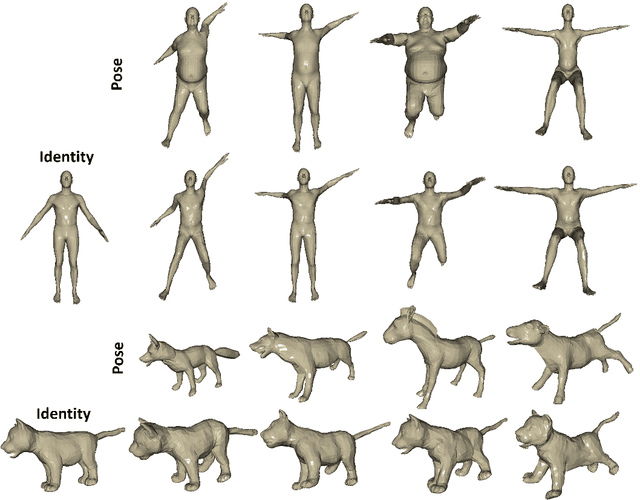



Abstract:3D pose transfer is one of the most challenging 3D generation tasks. It aims to transfer the pose of a source mesh to a target mesh and keep the identity (e.g., body shape) of the target mesh. Some previous works require key point annotations to build reliable correspondence between the source and target meshes, while other methods do not consider any shape correspondence between sources and targets, which leads to limited generation quality. In this work, we propose a correspondence-refinement network to help the 3D pose transfer for both human and animal meshes. The correspondence between source and target meshes is first established by solving an optimal transport problem. Then, we warp the source mesh according to the dense correspondence and obtain a coarse warped mesh. The warped mesh will be better refined with our proposed Elastic Instance Normalization, which is a conditional normalization layer and can help to generate high-quality meshes. Extensive experimental results show that the proposed architecture can effectively transfer the poses from source to target meshes and produce better results with satisfied visual performance than state-of-the-art methods.
CartoonRenderer: An Instance-based Multi-Style Cartoon Image Translator
Nov 14, 2019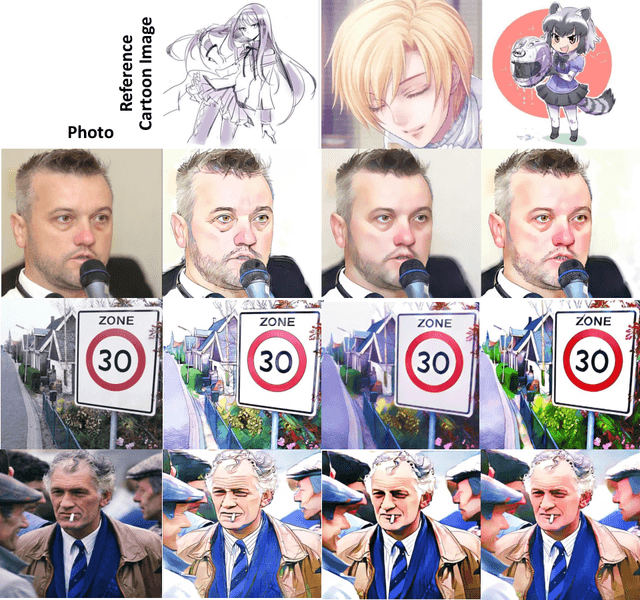
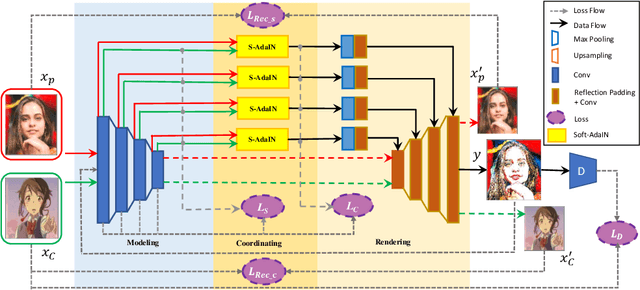
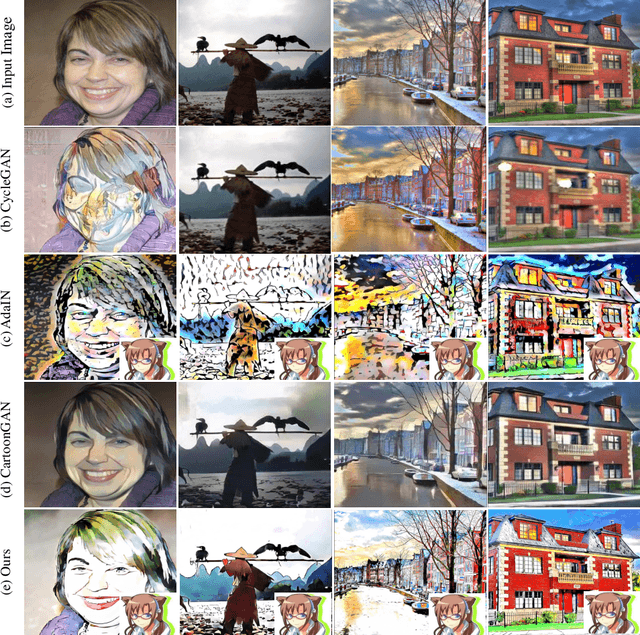
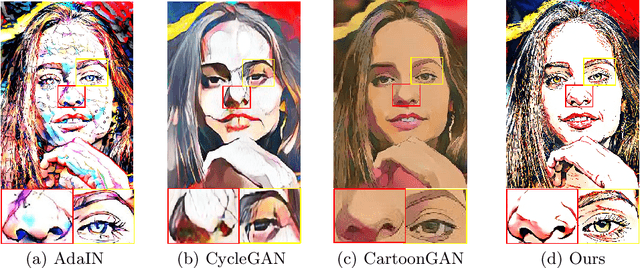
Abstract:Instance based photo cartoonization is one of the challenging image stylization tasks which aim at transforming realistic photos into cartoon style images while preserving the semantic contents of the photos. State-of-the-art Deep Neural Networks (DNNs) methods still fail to produce satisfactory results with input photos in the wild, especially for photos which have high contrast and full of rich textures. This is due to that: cartoon style images tend to have smooth color regions and emphasized edges which are contradict to realistic photos which require clear semantic contents, i.e., textures, shapes etc. Previous methods have difficulty in satisfying cartoon style textures and preserving semantic contents at the same time. In this work, we propose a novel "CartoonRenderer" framework which utilizing a single trained model to generate multiple cartoon styles. In a nutshell, our method maps photo into a feature model and renders the feature model back into image space. In particular, cartoonization is achieved by conducting some transformation manipulation in the feature space with our proposed Soft-AdaIN. Extensive experimental results show our method produces higher quality cartoon style images than prior arts, with accurate semantic content preservation. In addition, due to the decoupling of whole generating process into "Modeling-Coordinating-Rendering" parts, our method could easily process higher resolution photos, which is intractable for existing methods.
 Add to Chrome
Add to Chrome Add to Firefox
Add to Firefox Add to Edge
Add to Edge